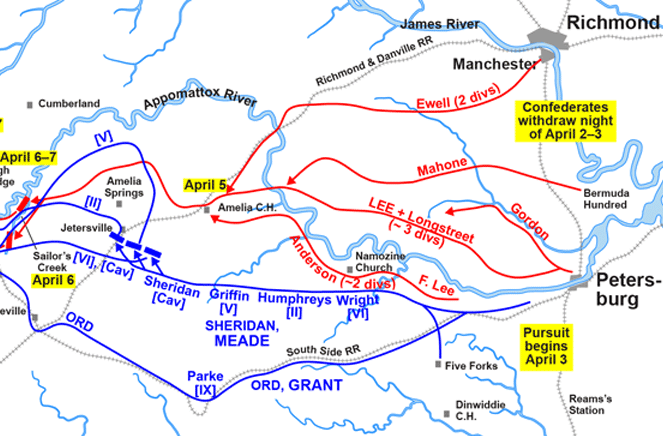“The only chance the Army of Northern Virginia had to save itself” – Jetersville, April 5, 1865

On the morning of April 5th, Maj. Gen. William Pendleton set out to destroy the artillery surplus munitions and cannon of the Army of Northern Virginia. The artillery supplies were sent to Amelia Courthouse from Richmond earlier that spring. Now Lee’s army, slowly consolidating at Amelia Courthouse, needed to lighten its load for a march to Danville. Chased out of Richmond and Petersburg, Lee’s objective was to join forces with Gen. Joseph Johnston’s army near Raleigh. His plan was to use the Richmond and Danville Railroad as his guide southward. Lee’s time at Amelia Courthouse had been a disappointment. Much needed rations were not waiting for his army and the various columns marching towards Amelia were slow due to straggling and long wagon trains. Spring rains had flooded rivers and creeks and forced major delays. Lee knew he was losing time and that Lt. Gen. U.S. Grant’s forces were quickly converging on his weakened army.
At that same time that Lee was in Amelia Courthouse, Federal cavalry and infantry under Maj. Gen. Philip Sheridan were racing westward to cut Lee’s suspected route south. Sheridan believed that Lee would consolidate at Amelia and try marching southward along the railroad. He wrote to Grant “we can capture the Army of Northern Virginia if force enough can be thrown to this point and then advance upon it.”
Federal cavalry under Maj. Gen George Crook arrived along the Richmond and Danville Railroad on the morning of April 4th. As Crook moved northward toward Amelia he intercepted a telegram from Lee calling for 200,000 rations from Danville to be sent northward along the railroad. Crook, now joined by the Fifth Corps, moved northward to Jetersville.

Jetersville was an “insignificant station on the railroad, comprising of half a dozen buildings all told…” The Federal force moved to within one mile of the village and began to entrench, knowing that Lee was moving in their direction soon. Sheridan called for assistance and the Second and Sixth Corps were on their way. Their expected time of arrival was midafternoon on the 5th. It would be a close call to see if Sheridan could hold Lee in place before the rest of Federal infantry could arrive.
Finally after a long delay, the Confederates began moving southward via the railroad late morning on April 5th. Jetersville and the Federal line were only 7 miles south of Amelia Courthouse. Scouting ahead of the Confederate infantry was Maj. Gen. “Rooney” Lee and his cavalry. As they came upon Jetersville the cavalry commander did not like what he saw.
He quickly rode back to his father and told the commanding general that there were Federals entrenched astride the railroad. He also reported it was a mixture of cavalry and infantry. Riding with Lee was Lt. Gen. James Longstreet and the three men conferred on their next steps. For a brief time it seemed that Lee would order an attack. As Brig. Gen. E.P. Alexander wrote “I never saw General Lee seem so anxious to bring on a battle in my life…” As Lee conferred with his lieutenants, it was determined more Federal infantry was close at hand. Any attack by the Confederates could open up their left flank to the arriving Federal infantry.

Later that afternoon Lee conferred with Maj. Gen. William Mahone on the situation. Mahone argued it was too late to attack as it was getting dark and that the best option was to try to move around the Federal left. Thus, no attack was made on the Federals at Jetersville. As Federal Brig. Gen. Charles Wainwright wrote “it seems so queer to me for Lee must have known that there was only one corps of infantry here, until quite late in the afternoon. I cannot understand it; for it was a grand chance for him.”
Though the Federals wrote after the war that Lee had a great chance to break out, Lee was aware that his army was still stretched out around Amelia. Thus they could not deliver a hard attack on the Federals. Also, Lee knew that more Federal infantry was close by and that they were coming from the east. This could open his left flank to attack and could be disastrous. The delay in getting his army consolidated and the delay in Amelia Courthouse trying to find provisions cost the Confederates dearly. Without these delays, it is possible that all Lee would have faced at Jetersville was cavalry.
That night, Lee’s army marched by night in the direction of Amelia Springs and Farmville. Lee’s hope was to move to Farmville to feed his army from supply trains waiting there. Then move south to Danville. But now, his beleaguered army traveled by small paths and rough roads, on a longer route than the Federals. His goal would be Farmville then Danville with no direct rail line to assist him. As Sheridan a month later recounted about Jetersville, it was “the only chance the Army of Northern Virginia had to save itself.”
Reblogged this on All things Confederate.